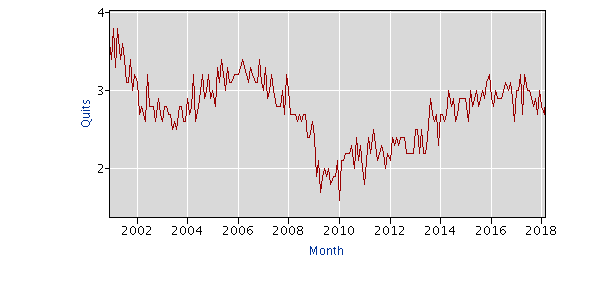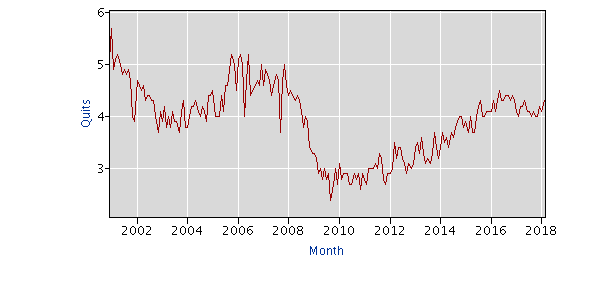May 21, 2018
Paul Krugman had an interesting blog post this morning in which he attributed the continuing weakness of wage growth to an increase in monopsony power. I’m a skeptic on this one since the collapse in wage growth happens to coincide with the Great Recession. The big issue is whether the labor market is again back to its prerecession level of tightness when wages were rising considerably more rapidly.
To argue the case that it is, Krugman follows Jason Furman in dismissing the drop in prime-age labor force participation as just being part of a longer-term trend. This leaves me uncomfortable for a couple of reasons.
First, it would be nice to have an explanation for the trend, instead of just pointing to it and saying “trend.” We have clear explanations for trends like rising incomes through time or increases in life expectancy. What is the explanation for fewer men interested in working through time? Will this decline persist forever?
That brings me to the second reason I am uncomfortable with this story. Insofar as there had been an explanation, it was usually that the skills of less-educated men were less valued in the modern economy. We no longer need strong people to move things around, machines do that for us.
There undoubtedly is some truth to this story, except the drop in employment rates (EPOPs) since 2007, and especially since 2000, has been pretty much across the board. EPOPs have fallen for both men and women and at pretty much all education levels. These drops are departures from past trends. (Women’s EPOPs had been rising until the 2001 recession.) A shortage of demand is the most simple explanation for why there would be a sudden drop in EPOPs hitting pretty much every demographic group.
The other piece of evidence Krugman and Furman cite is the rise in quit rates, which are back to their prerecession levels. I am less impressed. The problem is there is a composition effect. Fewer people are now employed in sectors with few quits, like manufacturing, and relatively more people are employed in sectors with frequent quits like retail trade and restaurants. This means that even if quit rates are lower within a sector, they can be higher for the economy as a whole.
Here’s the picture in retail.
Quit Rate in Retail Sector

Source: Bureau of Labor Statistics.
And the picture in restaurants.
Quit Rate in Leisure and Hospitality Sector

Source: Bureau of Labor Statistics.
In both cases, the quit rate is below the peaks hit in 2006 and 2007 and well below the peaks before the 2001 recession. In fact, the 4.3 percent quit rate in the restaurant sector is closer to the lows hit following the 2001 recession than the peaks in 2006 and 2007. For this reason, I don’t think the quit rate story supports the tight labor market argument. (It’s also worth noting that the share of unemployment due to voluntary quits is also below the 2006–07 levels and well below the peaks hit in 2000.)
So I still go for the slack labor market explanation for weak wage growth. This doesn’t mean monopsonistic labor markets may not be part of the story, but the big money is likely to be in pushing the labor market further.
Addendum
Jason Furman sent me a full composition-adjusted quit rate. While it is still slightly below the unadjusted quit rate, the difference is trivial, so we are essentially back to the pre-recession quit rates. (There was a shift to the low quit rate health sector, that largely offset the shift in employment to the high quit retail and restaurant sectors.)







Comments